A Short History
of the Lion & Lamb Chapter. No. 192
 The Lion & Lamb
Chapter was officially consecrated on January 10th 1872. at the
Cannon Street Station Restaurant London. The first MEZ was none
other than George Kenning of Toye Kenning & Spencer, Regalia
manufacturers. The Consecrating officer was Comp. Henry Muggeridge
PGStB, one of the most influential and respected Preceptors of
the mid to late 19th century and a member of the Lion & Lamb
Lodge.
The Lion & Lamb
Chapter was officially consecrated on January 10th 1872. at the
Cannon Street Station Restaurant London. The first MEZ was none
other than George Kenning of Toye Kenning & Spencer, Regalia
manufacturers. The Consecrating officer was Comp. Henry Muggeridge
PGStB, one of the most influential and respected Preceptors of
the mid to late 19th century and a member of the Lion & Lamb
Lodge.
At a regular
lodge meeting on 2nd March 1871 it had been proposed by W.Bro.Ebeneezer
Roberts and seconded by W Bro George Abbott, "That a Royal
Arch Chapter be formed in connection with the Lodge - to be called
"The Lion & Lamb Chapter". 'The same having been
put from the chair in the usual manner was carried unanimously'.
The Charter was obtained on November 1st 1871 with the consecration
itself on January 10th 1872.
The annual subscription
was £1.1s.6d. which was raised to £2.2s.0d. in 1877
and remained so until 1946 when it was raised to £2.12s.6d.
The Chapter met at the Cannon Street Station Restaurant until
1940. Due to the war, convocations for the May and October were
held over until February 1941 - by which time the restaurant had
been destroyed by enemy action. The new venue was at the Abercorn
Rooms and remained so until 1982 when we moved to The Gun Tavern
in Spitalfields and more recently here at the City University
Club.
On 31st January
1972 we celebrated our Centenary. The Centenary Charter was presented
by Ex. Comp. J.W.Stubbs - Grand Scribe E. Representing The Most
Excellent, The First Grand Principal to Ex. Comp. E.W.S. Press
MEZ.
I said it would
be a short history and so it is. On the death of a former Scribe
E. all the minute books were lost and so the only history available
since our consecration is that which is in the current minute
book, and in the memories of the present members.
However, we
have already come across an anomaly - The lodge was founded in
1789, but the chapter only in 1872 and as we all know, (or as
we have all been told), the Lion & Lamb Chapter has been in
existence as long as the lodge. But has it? - is there any evidence
to support this assumption or is it just speculation and hearsay.
So let us go
back to a time prior to 1872 and see whether there is any concrete
evidence to show that the chapter is older than the charter suggests,
and if so why the chapter was only officially recognised in 1872
The first Grand
Lodge, the Premier Grand Lodge was formed in 1717 in London. In
1751 a rival Grand Lodge was formed, The Atholl Grand lodge (named
after the patronage of the Dukes of Atholl) and was also known
as the "Grand Lodge of the Old Institution". The Premier
Grand Lodge had authorised certain variations to the ritual and
so the Atholl Grand lodge felt that they were working a more antient
and purer form of masonry. Under the Secretaryship of Laurence
McDermott he dubbed the Premier Grand Lodge "The Moderns"
since they had modernised the ritual and the Atholl Grand Lodge
which was much younger the Antients. A brilliant piece of spin
that many would be proud of today as it gave the Antients a sense
of superiority over the Moderns. There was often fierce rivalry
between the two Grand Lodges until the reconciliation and union
in 1813.
There is evidence
to show that Royal Arch Masonry was worked in the mid 18th century
by both the Moderns and the Antients the actual ritual probably
having come from Ireland or Scotland, but one of the differences
between the two Grand Lodges is how they perceived the importance
of the Royal Arch. The Moderns did not approve of it a felt it
was contrived and rather held their noses up at it, but allowed
its practice in chapters separate to the Lodge. The Antients took
a totally opposite view, regarding it as an integral part of their
system and working it in their lodges as a 4th Degree. Laurence
McDermott described the Royal Arch as the "heart and marrow"
of Freemasonry.
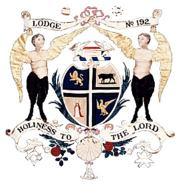 This fundamental approval
of Royal Arch is evidenced in the heraldic motifs on the Lion
And Lamb Lodge Banner - itself styled on the Antients coat of
arms depicting on the shield, a Lion an Ox a Man and an Eagle
and represented here in the Chapter.
This fundamental approval
of Royal Arch is evidenced in the heraldic motifs on the Lion
And Lamb Lodge Banner - itself styled on the Antients coat of
arms depicting on the shield, a Lion an Ox a Man and an Eagle
and represented here in the Chapter.
As the Lion
& Lamb Lodge was an Atholl Lodge, then it would be quite consistent
for it to be working the Royal Arch ritual in its Lodge meetings,
but is there any evidence to support this.
Minutes in those
days were much less informative than today and from records of
other Antients lodges it would appear that it is a rarity for
any mention of the Royal Arch to be found in them and that if
there were any kept, it would be in a separate book. Very few
survive today. Our own first minute book makes rather boring reading.
The only ritual that is recorded is that of installing the officers
and the giving of a lecture in the first degree, no mention of
any Initiations, Passings or raisings in the first 6 years. So
what work were they doing? They must have been taking on new members
if only to survive.
A clue comes
in the opening sentence of each entry.
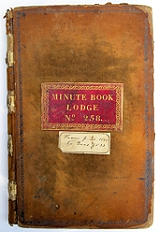 May 13th 1790
May 13th 1790
Opened at 8 O'clock in the Master
Worshipful Master & Officers present
Dec 10th 1790
Opened at 7 O'clock in the Second degree
Worshipful Master & Officers present
Jan 12th 1792
Opened at 8 O'clock in the Prentice
Worshipful Master & Officers present
Click on picture to enlarge
I suggest that
this indicates what ritual was being worked without any particulars
of that work being given.
So when the
Brethren opened in the 'Master' it is reasonable to presume that
this would be the 3rd degree followed by the fourth degree (which
were integral to each other) Royal arch being the 4th Degree.
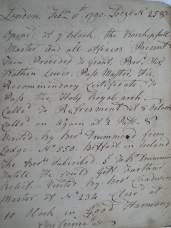 This is confirmed on the very first
minute on 11th February 1790 where it states that " To proceed
to grant Bro Sir Watkin Lewis his recommendary Certificate to
pass the Holy Royal arch…
This is confirmed on the very first
minute on 11th February 1790 where it states that " To proceed
to grant Bro Sir Watkin Lewis his recommendary Certificate to
pass the Holy Royal arch…
According to
Thomas Hughan, the leading Masonic historian of the late 19th
Century and who wrote the Centenary History of the Lion &
Lamb Lodge these words are the Royal Arch equivalent to the Craft
minutes reading "to ballot for and if approved initiate"
which the lodge would then be empowered to do under its Craft
Warrant. There are frequent entries in the minute books to this
effect in the subsequent years indicating our working of the Holy
Royal Arch Ceremony. But even so, this could be said to be only
speculation.
Concrete evidence
appears on Sunday 26th January 1812.
I have already
said that if minute books had been kept, it was the norm that
they would be separate from the Craft minutes and that in any
event none remain to this day.
Click
on picture to enlarge
The entry in
the Lodge Minute book for this date minutes a regular lodge meeting.
Then on a separate page with the same date:
Holy Royal Arch
Chapter, conven'd in due form at the Hope and Anchor, Union Street,
Blackfriars. Companions present:
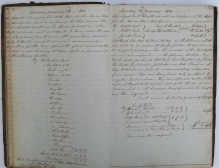 Robert Gill )
Robert Gill )
Willm Oaks ) Chiefs
Jas McCann)
Zacchs Hunter
) Scribes
Thos Southerland)
Jas Palmer)
Wn Tucker) Sojouners
Wm Smith)
Click on picture to
enlarge
The minutes of the last chapter meeting were read and confirmed.
There then lists the names of several Brethren - having produced
recommendary certificates from same Lodge, and being found duly
qualified by regular examination - they were afterwards exalted
to the Degree of Royal Arch Masons and paid the fee of 1 Guinea.
Why this minute
should appear in the Lodge minute book is a total mystery but
its existence, especially referring to previous minutes, proves
I think beyond all reasonable doubt that this Chapter was in existence
from 1789.
So why then
is the Chapter only officially recognised in 1872?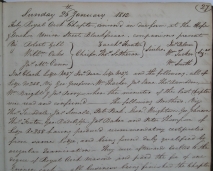
Following the
union of both the Antients and the Moderns in 1813 much work had
to be done and it wasn't until 1817 that the Grand Master could
turn his attention to the Royal Arch. On 18th March 1817 Royal
Arch Members of both the former Grand Lodges were summoned to
Grand Lodge and the 'United Grand Chapter of England' was formed,
that title being quietly changed (so as not to offend the Antients)
to 'Supreme Grand Chapter' in 1821.
One of the decrees
of the United Grand Chapter was that former Antients Lodges were
to cease working the Royal Arch within their Lodges and for those
Lodges to petition for a Charter forming them into a chapter attached
to that lodge, and the date of that charter would then be dated
along with the consecration date of the Lodge. This had to be
effected within a reasonable time.
Click
on picture to enlarge
Had the Loin
and Lamb petitioned for a charter, then this Chapter would have
been celebrating it's Bi-Centenary along with the lodge 18 years
ago, but it failed to do so. Why should this be? Why did the lodge
not petition? I can only suggest 4 possible reasons
1) Ignorance
2) Error
3) Apathy
4) Arrogance.
Let us examine these.
1) Ignorance:
Were we unaware that we had to petition for a new charter?
The Lion & Lamb Lodge had three members on the Committee charged
with overseeing the Union. Thomas Harper, Goldsmith, was a member
of the Lodge and was Deputy Grand Master at the Union Ceremony.
Peter Thompson DC was among the three first and most respected
Preceptors in the Lodge of Reconciliation formed to standardise
the ritual. We were meeting in the heart of London, not in some
far flung corner of the country or the globe.
It is for these reasons that it is inconceivable that we were
unaware.
2) Error: Was it an administrative error that the Secretary did
not petition or left it too late?
If so this error
continued without being spotted for over 50 years! Again, this
cannot be a valid reason.
3) Apathy: How could it be that the brethren just couldn't be
bothered to apply. These were dramatically changing times in Freemasonry
and the Lion & Lamb Lodge was at the cutting edge of all the
changes as I have already pointed out. This similarly cannot be
the reason.
There can only
one other reason:
Arrogance!
I must state
here that there is no foundation for any of the comments I am
about to make, it is purely personal speculation.
The Lion &
Lamb Lodge has for all its history been partial to Arrogance and
a feeling of Self Importance & Superiority, and historically
it has every right to be.
I have already mentioned Thomas Harper DGM and member of the Lodge.
three lodge members on the Union Committee. Peter Thompson and
his successor Henry Muggeridge, two of the most influential Preceptors
of the 19th Century. George Kenning, Regalia Manufacturer to name
but a few.
This trend towards arrogance and self importance still lives on
to this day as many of the Lodge members here will testify. Not
a year goes by without the words "Well that's the way we've
always done it, I don't see why we should change now just because
Grand Lodge tell us to - After all we're older than them!"
being heard either in the Lodge or in the L of I.
Could it have
been from feelings like this that the Lodge Members decided in
a fit of peke that they "would not have anything to do with
this new Grand Chapter thing" and have just ignored it. I
think not. After nearly 30 years of including Royal Arch Ritual
within the Lodge ceremonies, to just cut it out and forget about
it is hardly in the spirit of the Lion & Lamb.
The only other
alternative is that with that same arrogance the members continued
to practice the Royal Arch rituals underground in a clandestine
way working under their original warrant. It is entirely feasible.
No mention in the Lodge minute book - there never was except for
one meeting. There were no official Chapter Certificates in those
days so that would not have been a problem.
It would only
have been after many years of working this way that the companions
would realise that the lack of recognition by Supreme Grand Chapter
would thereby not allow progression for honours, and maybe after
a time, with so many distinguished brethren in the Lodge, our
'irregular working' may have come to Grand Lodge's attention and
that the Lodge was 'lent on' from above to conform.
I would like
to think this the case although I have no proof of this. Either
way, for whatever reason it was, the Lodge shot itself in the
foot and being unable to prove continuous existence (even with
possible irregular meetings) the date of its consecration remains
as 1872.
I will leave
you to make up your own minds.
E. Comp. Dr
Simon Marner. LGCR. MEZ.
 The Lion & Lamb
Chapter was officially consecrated on January 10th 1872. at the
Cannon Street Station Restaurant London. The first MEZ was none
other than George Kenning of Toye Kenning & Spencer, Regalia
manufacturers. The Consecrating officer was Comp. Henry Muggeridge
PGStB, one of the most influential and respected Preceptors of
the mid to late 19th century and a member of the Lion & Lamb
Lodge.
The Lion & Lamb
Chapter was officially consecrated on January 10th 1872. at the
Cannon Street Station Restaurant London. The first MEZ was none
other than George Kenning of Toye Kenning & Spencer, Regalia
manufacturers. The Consecrating officer was Comp. Henry Muggeridge
PGStB, one of the most influential and respected Preceptors of
the mid to late 19th century and a member of the Lion & Lamb
Lodge.



